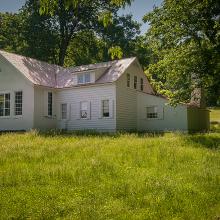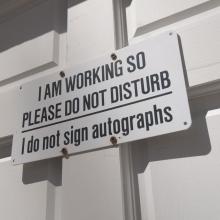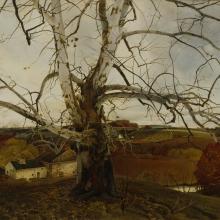
Andrew Wyeth Studio, Brandywine Museum of Art
Andrew Wyeth, b 1917- d 2009Brandywine Museum of Art,
1 Hoffman’s Mill Road, Chadds Ford, PA 19317 - view on Google Maps
610-388-2700
610-388-2700
“To better understand my father’s world, one need only visit his studio.”
—Jamie Wyeth
A converted schoolhouse, this is the primary studio of Andrew Wyeth, in continual use from 1940 until shortly before the artist’s death in January, 2009. The studio is the center of Wyeth’s Pennsylvania world, the rich microcosm that inspired and nourished his art.
ABOUT
In 1940, the young Andrew Wyeth and his new wife Betsy moved into a converted schoolhouse, just down the lane from where Andrew had grown up. The Wyeths would live – and Andrew would work – in this building for the next twenty years. In the early 1960s, the Wyeths acquired a new home, but the old schoolhouse remained Wyeth’s major Pennsylvania studio where he painted for another five decades.
The schoolhouse had already been used by Wyeth’s sister, Henriette, and brother-in-law Peter Hurd, as both studio and home. Wyeth’s sons, Jamie and Nicholas, remember a life integrated with art—visiting their father in the studio room, or having guests come to look at newly completed paintings that Andrew often hung in the kitchen. While Wyeth ventured out to select and sketch various motifs in the countryside, his major temperas were always painted in the studio.
The painting studio is presented almost as it appeared shortly before Wyeth’s death. Watercolor and tempera material give visitors a sense of the artist’s craft. The building still houses Wyeth’s art library and his extensive collections of military miniatures, costumes, and paintings by Howard Pyle. The high-ceilinged, sparsely-furnished former schoolrooms reflect Wyeth’s austere aesthetic and earth-toned palette. The tall, paned windows create details on the landscape that speak to the way Wyeth constructed some of his compositions; they also infuse the interior spaces with natural light that was so important to the artist.
Following Andrew Wyeth's death in 2009, Betsy donated the property to the Brandywine Museum of Art. During Wyeth’s lifetime, the studio was a very personal space, and the artist protected the privacy he felt necessary to his work. The artist posted a sign on the door that says: “I am working so please do not disturb.” Although the sign remains, we are now welcome to visit this very special place.
The schoolhouse had already been used by Wyeth’s sister, Henriette, and brother-in-law Peter Hurd, as both studio and home. Wyeth’s sons, Jamie and Nicholas, remember a life integrated with art—visiting their father in the studio room, or having guests come to look at newly completed paintings that Andrew often hung in the kitchen. While Wyeth ventured out to select and sketch various motifs in the countryside, his major temperas were always painted in the studio.
The painting studio is presented almost as it appeared shortly before Wyeth’s death. Watercolor and tempera material give visitors a sense of the artist’s craft. The building still houses Wyeth’s art library and his extensive collections of military miniatures, costumes, and paintings by Howard Pyle. The high-ceilinged, sparsely-furnished former schoolrooms reflect Wyeth’s austere aesthetic and earth-toned palette. The tall, paned windows create details on the landscape that speak to the way Wyeth constructed some of his compositions; they also infuse the interior spaces with natural light that was so important to the artist.
Following Andrew Wyeth's death in 2009, Betsy donated the property to the Brandywine Museum of Art. During Wyeth’s lifetime, the studio was a very personal space, and the artist protected the privacy he felt necessary to his work. The artist posted a sign on the door that says: “I am working so please do not disturb.” Although the sign remains, we are now welcome to visit this very special place.
Did you know...?
As a boy Andrew Wyeth collected military miniatures, and throughout his life he received them as gifts. There are now over 900 of them displayed in the Andrew Wyeth studio.SPECIAL RESOURCES
The Brandywine River Museum of Art devotes a complete gallery to Andrew Wyeth’s work and often features special exhibitions that explore aspects of his art.
New in 2021 - Virtual Tours of the Andrew and N.C. Wyeth Studios
view on Google Maps
NEARBY SITES
- N. C. Wyeth House and Studio, Brandywine Museum of Art0 mi.
- The Wharton Esherick Museum15.64 mi.
- Demuth Museum39.34 mi.
- Fonthill Castle39.86 mi.
WHAT TO DO HERE
- Tour the studio with a trained guide.
- Visit the Brandywine Museum of Art to see the Andrew Wyeth gallery.
- Take a guided tour of the nearby Kuerner Farm, Andrew Wyeth’s inspiration for a major body of work created between 1933 and 2009.
- Walk along the Brandywine and other museum trails to experience the countryside, a constant source of inspiration to Wyeth.
- Expand the Wyeth story by visiting the studio of Andrew’s father, N. C. Wyeth.
YOU CAN ALSO SEE THE ART HERE:
- Farnsworth Art Museum, Rockland, ME
- Greenville County Museum of Art, Greenville, NC
- Frye Art Museum, Seattle, WA
- Kemper Museum of Contemporary Art, Kansas City, MO












